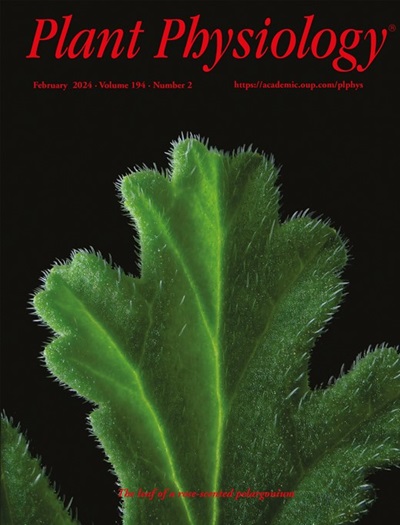光调控PEP活性的双靶向核控制通过胞间通讯建立光形态发生
IF 6.9
1区 生物学
Q1 PLANT SCIENCES
引用次数: 0
摘要
在真核细胞中,细胞间通讯对于维持细胞和细胞器功能以及适应动态环境变化至关重要。在被子植物中,光通过光感受器(如红/远红感光色素)及其下游信号通路启动光形态发生,这是一个以叶绿体生物发生和抑制下胚轴伸长为特征的发育过程。然而,在光形态发生过程中,核-叶绿体串扰的机制尚不清楚。在这里,我们发现光调控的核控制PEP活性(NCP)的双靶向通过替代启动子选择和逆行易位介导细胞核和叶绿体之间的双向通信。光促进上游规范转录起始位点的转录,产生一个长NCP异构体(NCP- l),其中包含一个n端叶绿体转运肽,指导叶绿体定位。相反,黑暗或低红光条件有利于下游替代起始位点的转录,产生更短的细胞质异构体(NCP-S),该异构体通过26S蛋白酶体迅速降解。这种光调控的转录起始依赖于光形态发生的关键抑制因子——光敏色素相互作用因子(pif)。在叶绿体输入后,NCP-L被加工成成熟形态(NCPm),促进PEP复合物的组装和类核定位,启动叶绿体的生物发生。值得注意的是,NCP的细胞核功能需要其事先定位于叶绿体,这支持了NCP介导叶绿体到细胞核逆行信号传导的模型。与此一致的是,NCP促进拟南芥(拟南芥)下胚轴的基质形成,将叶绿体动力学与光敏色素依赖的核途径联系起来,限制下胚轴伸长。我们的发现揭示了一种胞间通讯机制,其中光依赖性替代启动子的使用和逆转录调节光形态发生,整合核和质体信号来协调器官特异性发育程序。本文章由计算机程序翻译,如有差异,请以英文原文为准。
Light-regulated dual-targeting of NUCLEAR CONTROL OF PEP ACTIVITY establishes photomorphogenesis via interorganellar communication
Interorganellar communication is essential for maintaining cellular and organellar functions and adapting to dynamic environmental changes in eukaryotic cells. In angiosperms, light initiates photomorphogenesis, a developmental program characterized by chloroplast biogenesis and inhibition of hypocotyl elongation, through photoreceptors such as the red/far-red-sensing phytochromes and their downstream signaling pathways. However, the mechanisms underlying nucleus-chloroplast crosstalk during photomorphogenesis remain elusive. Here, we show that light-regulated dual-targeting of NUCLEAR CONTROL OF PEP ACTIVITY (NCP) mediates bidirectional communication between the nucleus and chloroplasts via alternative promoter selection and retrograde translocation. Light promotes transcription from an upstream canonical transcription start site, producing a long NCP isoform (NCP-L) containing an N-terminal chloroplast transit peptide that directs chloroplast localization. In contrast, darkness or low red-light conditions favor transcription from a downstream alternative start site, producing a shorter cytoplasmic isoform (NCP-S) that is rapidly degraded via the 26S proteasome. This light-regulated alternative transcription initiation depends on PHYTOCHROME-INTERACTING FACTORS (PIFs), key repressors of photomorphogenesis. Upon chloroplast import, NCP-L is processed into its mature form (NCPm), which promotes assembly and nucleoid localization of the PEP complex to initiate chloroplast biogenesis. Notably, NCP’s nuclear function requires its prior localization to chloroplasts, supporting a model in which NCP mediates chloroplast-to-nucleus retrograde signaling. Consistent with this, NCP promotes stromule formation in Arabidopsis (Arabidopsis thaliana) hypocotyls, linking chloroplast dynamics to phytochrome-dependent nuclear pathways that restrict hypocotyl elongation. Our findings uncover an interorganellar communication mechanism in which light-dependent alternative promoter usage and retrotranslocation regulate photomorphogenesis, integrating nuclear and plastid signals to coordinate organ-specific developmental programs.
求助全文
通过发布文献求助,成功后即可免费获取论文全文。
去求助
来源期刊

Plant Physiology
生物-植物科学
CiteScore
12.20
自引率
5.40%
发文量
535
审稿时长
2.3 months
期刊介绍:
Plant Physiology® is a distinguished and highly respected journal with a rich history dating back to its establishment in 1926. It stands as a leading international publication in the field of plant biology, covering a comprehensive range of topics from the molecular and structural aspects of plant life to systems biology and ecophysiology. Recognized as the most highly cited journal in plant sciences, Plant Physiology® is a testament to its commitment to excellence and the dissemination of groundbreaking research.
As the official publication of the American Society of Plant Biologists, Plant Physiology® upholds rigorous peer-review standards, ensuring that the scientific community receives the highest quality research. The journal releases 12 issues annually, providing a steady stream of new findings and insights to its readership.
 求助内容:
求助内容: 应助结果提醒方式:
应助结果提醒方式:


